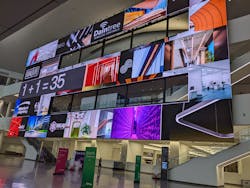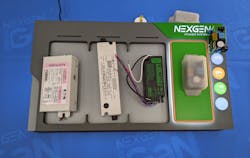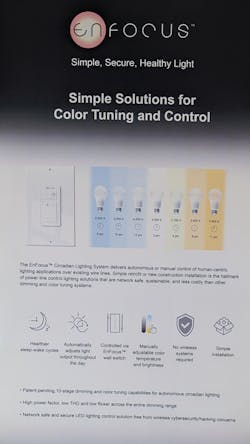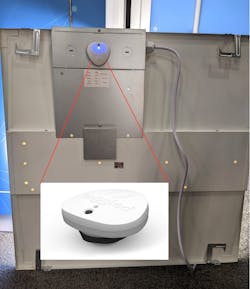As our team processed the recent trip to the Las Vegas Convention Center West Hall for LightFair International’s exhibition (June 21–23, 2022), themes of controls simplification, interoperability, and streamlined systems experience emerged from several booth visits.
NexGen Power Systems
It may seem puzzling to combine discussion about LED drivers and power electronics with lighting controls technology. However, as we learned from NexGen Power Systems CEO and cofounder Dinesh Ramanathan, recent advances in power electronics can deliver lower cost, a more compact footprint, lighter product weight, and improved dimming performance, for example.
Ramanathan showed a retail-model Cree Lighting downlight incorporating NexGen’s megahertz-switching-frequency Vertical GaN technology, which utilizes smaller inductor and electromagnetic interference filter (EMI) components. With around 20W of power, the downlight was able to perform ~5% steps in dimming smoothly — without flicker but with 6% greater efficiency compared to typical 16W competitive technology.
As far as the company’s long-term view, Ramanathan explained that in the five years since its founding, NexGen Power Systems has managed to acquire more than 100 patents involving process technology, and device, circuit, and power systems architecture. The company plans to scale its software-configurable power technology to address systems from 20W to 200 kW. Beyond general computing and lighting systems, this will include data centers and electric vehicles for a more diversified approach to company growth.
Readers can access an on-demand webinar presented by applications engineer Tiziano Pastore on the scalable NexGen Power technology that resulted in developing Helios power modules for SSL systems.
Energy Focus’ EnFocus controls
Although known for its heavy-duty and commercial-grade lighting, Energy Focus has made forays into controls, recognizing challenges that continue to deter end users from seeking sophisticated solutions.
“Market penetration of [lighting] controls is about 1% with incentives, rebates, and code requirements considered,” senior vice president, product management and engineering Greg Galluccio said during our visit. While acknowledging that wireless controls have become popular in residential spaces, commercial and industrial end users — such as administrators and facilities operators with security concerns in educational, healthcare, government, and prison environments — are more wary of devices that can “forget to pair and lose connection,” Galluccio said. Still, wired-system costs estimated from $7,000 to $10,000 to pull new wiring for individual classrooms can be prohibitive, for instance, and interoperability is a major concern, he explained.
Energy Focus developed its EnFocus controls and switching technology to provide dimming and color tunability — including support for circadian lighting schemes — over existing AC mains or wiring run in new builds. Proprietary waveform technology cleans up “dirty” 120V input signal, Galluccio said, with a small (about 2 in.2) translator module that fits into the driver/controls box and communicates with any 0–10V lighting system.
In Galluccio’s opinion, “the initial wave of controls was too sophisticated,” intimidating potential commercial users with cost and complexity. “Simple, intuitive, and invisible” will win them over, he reflected.
Toggled builds out controls portfolio
Altair subsidiary Toggled touts its mission as “user-friendly” software-based building and lighting control solutions. Adding to its Toggled iQ lineup of IoT and lighting controls, the company exhibited its latest fixture controller. In conversation with COO Daniel Hollenkamp, he reiterated the accessibility, flexibility, and ease-of-use pain points — but with the added pressure of organizations’ sustainability initiatives and potential complications of integrating both lighting and building systems. “We want to make this easier,” he said. “Less intimidating, simpler to plan and implement” because additional maintenance and troubleshooting costs facilities owners and operators in both time and money, Hollenkamp explained.
In 2021, he continued, the company introduced its Toggled iQ smart building platform — a “building ecosystem” with direct-wire LED lighting, sensors, and switches for scalable, end-to-end connectivity. Hollenkamp then showed the newly launched fixture controller with two 0–10V inputs to control dimming and CCT of existing 0–10V dimmable fixtures, communicating with the Toggled iQ platform. “We can help implement daylight harvesting, occupancy detection-based control, and scheduled lighting programs with this complete smart platform” in a cost-effective manner, claimed Hollenkamp. He pointed out the threaded adapter that simplifies installation of the controller in standard ½-in. knockouts (shown in nearby exhibit photo).
The controller is designed to be used as a standalone device or scaled to a full building network. “This is smart and wireless — how it should be,” Hollenkamp said. “No tearing down existing infrastructure or complex wiring diagrams.”
Compelling controls chat with Kenall
Last but not least, we had an interesting and enlightening chat with BrightStar Award honoree Kenall Lighting’s Nathan Heiking. As we conversed in the media center about the lighting developer’s BrightStar-recognized EnviroPro IN9 natatorium luminaire, LEDs asked about product and application expansion efforts. Product manager Heiking revealed that Kenall is working with ex-Motorola employees contributing their electrical engineering, software development, and wireless radio experience to boost “resources dedicated to advanced controls technology.”
He described a camera-based cloud application under development that would integrate with pole-mounted lights: an imaging sensor with visual correction optics, as well as a learning algorithm, to resolve camera distortion and filter out image noise, respectively, for integration with outdoor or parking garage lighting, for example, to read license plates and provide other security and controls capabilities. “We’re working it into a simpler wireless version at a lower cost – similar to Bluetooth mesh, but not that protocol,” said Heiking. We look forward to learning more as progress is announced.
CARRIE MEADOWS is managing editor of LEDs Magazine, with 20 years’ experience in business-to-business publishing across technology markets including solid-state technology manufacturing, fiberoptic communications, machine vision, lasers and photonics, and LEDs and lighting.
For up-to-the-minute LED and SSL updates, follow us on Twitter. You’ll find curated content and commentary, as well as information on industry events, webcasts, and surveys on our LinkedIn page and our Facebook page.








